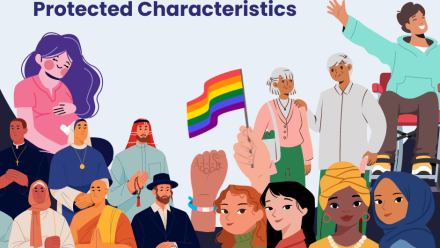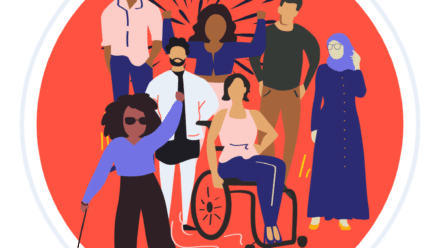What’s the difference between Capital D Disabled and lowercase d disabled?
25th July 2023 by Scarlett James

What’s the difference between Capital D Disabled and lowercase d disabled?
Within the Deaf community, there is often a distinction made between talking about being capital D Deaf, or lowercase d deaf. It’s important to reflect on the language we use in regards to Deafness as it reflects our cultural assumptions. In the past, the language used to describe deaf people has stemmed from a deficit medical model of disability.
Those who choose to identify with ‘deaf’ may understand their deafness as a condition, also identify as disabled, and may not use BSL. Those who choose to identify with ‘Deaf’, may view themselves as culturally Deaf, may be active within the Deaf community and often use BSL. It is critical to remember, however, that an individual’s preferences should be respected and valued. Our inclusion consultant Jasper reflected on his Deaf identity last year for Deaf Awareness Week.
If you’re worried about getting it right, remember the golden rule is to respect individuals’ preferences. More broadly, Jasper recommends using the lower case d when referring to deaf individuals and a capital to talk about the Deaf community.
You can read SignHealth’s article about big D/little d in the deaf community to find out more.
What about in the wider disability community? Does disabled need to have a capital d?
Within the disability community, there is a difference of opinion around whether to capitalise the D in disabled. For many, the use of a capital “D” in “Disabled” reflects a shared identity and an ongoing commitment to advocate for rights and equality. Embracing “capital D Disabled” can be seen as demonstrating alignment with the social model and identity-first language, signifying pride in being part of this community and actively engaging with Disabled culture.
Adam Hyland, our Director of Accessibility and Inclusion, uses capital D Disabled: “For me, it’s about identity. Whilst I want a world where we don’t have labels or terms, we’re not there yet. I think it should be seen as an identity because we need to identify as a group of people who are fighting against stigma, discrimination and barriers in society.’
However, it is essential to recognise that not every disabled person will choose to identify as “capital D Disabled.” It is important to respect individual preferences when it comes to self-identification.
“I prefer to use lowercase d for disabled because I like that it remains a verb,” says one D&A team member. “I am being disabled by the barriers I face in society”
Why is it important to know about capital D and lowercase d disabled?
Understanding the distinction between “capital D” and “lowercase d” Disabled is crucial as it challenges negative assumptions and attitudes about disability. By promoting positive conversations and fostering a sense of pride, belonging, and trust within the community, we can contribute to a more inclusive and supportive environment for all.
This Disability Pride Month is a great time to reflect on your own identity.
‘I proudly identify as Disabled and before working at D&A wasn’t sure if I was ‘allowed’ to claim that word.’ Molly Jones, our Operations Lead says.
Do you identify as Disabled, or disabled?
‘I use d/Disability interchangeably. I think it’s most important to reclaim the word disability with pride and to honour people’s personal preferences.’ one of our Inclusion Consultants Solène Anglaret points out.
However you identify, our AXS passport enables you to communicate your needs to employers, teachers, lecturers or doctors in a simple and solution-focused way. Create your own passport.


